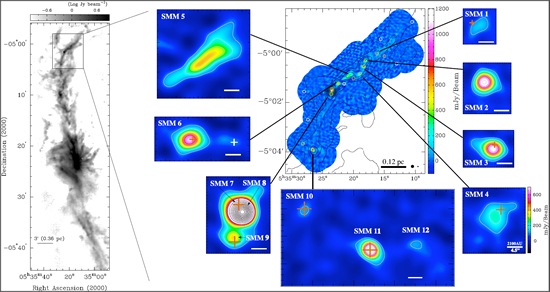Research Gallery > The SAO/ASIAA Submillimeter Array (SMA)
Research Gallery
The SAO/ASIAA Submillimeter Array (SMA)
| The SMA successfully imaged the thermal dust emission at 0.85 mm from the 0.9 x 0.3 pc area of Orion Molecular Cloud-3 (OMC-3), which is located to the north of Orion nebula M42 |
|
Image Credit: Takahashi

Left: Filamentary structure observed in the Orion Molecular Cloud obtained in the 850 µm continuum emission taken with the JCMT/SCUBA (Johnstone & Bally 1999) Right: SMA 850 µm continuum image (color) obtained with 85-pointing mosaic observations overlaid with the 850 µm continuum image taken with the JCMT/SCUBA (black contours)
|
| The technique of multi-pointing mosaicking allows us to cover an area much larger than the area covered by a single- field. The presented SMA image shows a 85 pointing mosaic observations of the northern part of the Orion filamentary molecular cloud through thermal dust emission (0.85mm continuum emission). The image reveals that the filament consists of a chain of clumps with a semi-regular interval of 0.05 pc. This separation is roughly consistent with the local Jeans length, suggesting that observed star-forming cores may be formed via thermal fragmentation process within the filaments. The detected clumps are spatially resolved, and are likely to harbor protostars. (Takahashi et al. 2013, ApJ, 763, 57) |
 asiaa.sinica.edu.tw Media Request: epo
asiaa.sinica.edu.tw Media Request: epo asiaa.sinica.edu.tw
asiaa.sinica.edu.tw 